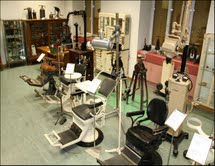Museum of Dentistry "Luis de Macorra"
Collections
![]()
The practice of dentistry requires specific and sophisticated material which has evolved as the instrumental techniques have been developed. Dentistry is one of the first medical specialties to introduce the use of instrument equipment. Needles and stilettos have been found in archaeological sites; and dental pelicans have been common instruments since the 16th century. However, it was not until late 19th century that dentistry became a speciality in its own right. And dental instruments became more complex taking advantage of the basic science advances, such as the use of electricity.
History
![]()
The Museum of Dentistry houses more than five hundred artefacts and objects of different types that tell the visitor the history and evolution of dental practice. The collection is made up mainly of 19th- and 20th-century items, and it includes normal dental anatomy and a wide range of dental pathologies, learning material, tools and dental instruments such as forceps used for tooth extraction and anesthetic equipment. Amongst many other items of interest, the museum houses an impressive collection of dental chairs, offering visitors an insight into the history of this peculiar piece of furniture: the first dentists" chairs were simple sitting chairs that had been slightly modified; they then moved on to focus on ergonomics and comfort, allowing professionals to have the proper environment to treat patients.
The introduction of radiology in the early 20th century was an essential advance in the diagnosis. The X-ray equipment became widespread in dental practices in the early decades of the last century. The "Florestán Aguilar" Museum shows a selection of this kind of equipment.
Mr Florestán Aguilar was the Spanish Royal House’s dentist in 1900 and shortly afterwards the dentist of the Royal Houses of Bavaria and Austria. As a consequence of his exceptional positions of lecturer and Royal dentist, he obtained permission to visit dental education institutions in Europe and the United States. In 1914 the School of Dentistry was established at his request and he worked there as a professor.
In 1927 he became a member of the Board of the “Ciudad Universitaria” campus in Madrid. His good relationship with King Alfonso XIII allowed him to play a leading role in the building of the “Ciudad Universitaria” campus. Consequently, Dental Studies were given the recognition they had never had before. His vision of the American college campus influenced the conception and design of “Ciudad Universitaria” campus.
His relevant social and professional position allowed him to have an impressive specialised library; the archives and furniture are kept in this museum.
The museum does not have a published catalogue, but some of its items have been studied by Dr. Luis de la Macorra Revilla. There is, nevertheless, a specific. monograph on dentist treadle drills available (RCOE, 2003: 8 (2), 305-314).


